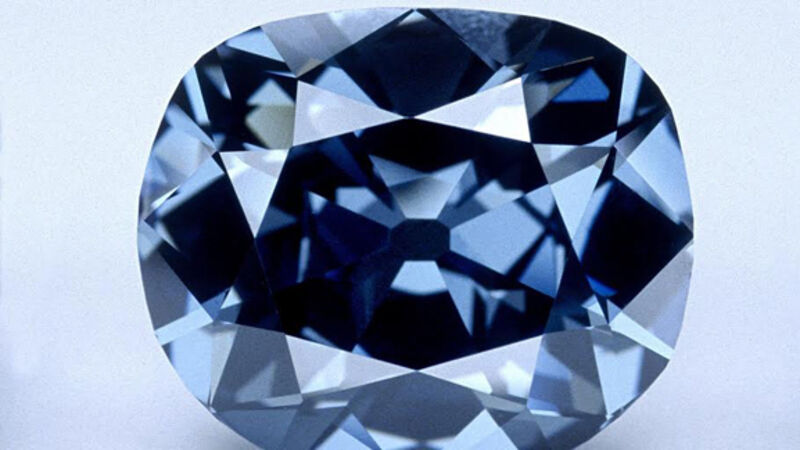Vintage View: The Hope Diamond

Greyish blue, at 45.5-carats in an antique cushion cut with faceted girdle — this is treasure beyond the wildest dreams of even the everyday billionaire, but it’s a stone with a dark reputation.
For 200 years it could only be speculated that the gigantic, blue diamond first recorded in the mid-17th century, was the same stone sitting behind bulletproof glass at the Smithsonian National History Museum in Washington DC. The world’s famed blue rock was first passed on (and likely stolen), by French gentleman-explorer, Jean Baptiste Tavernier, in the ancient city of Guntur near the Bay of Bengal in India.
Discovered in a local mine, the 1.1 billion-year-old diamond was only roughly cut and in the rough, a monster at an estimated 112-116-carats. Tavernier was a character of many talents and curiosities and patronised by the French crown. He amused the Sun King, Louis XIV, with florid writings about his trips to the East and Far East, and regularly brought his mercurial majesty flashy piracy for his wardrobe.
On his return from India at some point in the 1660s (Tavernier was dashing, but hopeless with dates in his biographies), the massive azure stone was passed onto the court jeweller of Louis, along with a job lot of 1,000 diamonds. The king was tickled, and gave Tavernier the equivalent prize of 147 kilos of gold (just shy of €4,600,000 today with hefty change), and threw in a rather nice title.
As for the stone, having ignored it for about ten years, Louis had his man spend two years cutting the diamond into a 67-carat jewel set in gold which the king wore on a ribbon- and it became known more widely as the French Blue. By 1793, there was no longer a firm draping position for any stone on a French king’s neck and with the confusion and lootings of the Revolution and demise of the royal couple, the stone disappeared.
Following over two centuries of conjecture we now know that the diamond made its way through the hands of various carpet baggers and rogues to England, where by 1812 it had been cut down, possibly to conceal its identity — the remaining segment reborn as what we know today as the Hope Diamond.
How do we know this beyond a reasonable doubt? In 2005 a lead model of the French Blue was found in the French Natural History Museum, allowing scientists to credibly reconstruct the original lost stone and cradle it around the Hope Diamond using computer aided technology.
Diamonds are highly individual, and the Hope Diamond sat perfectly inside a virtual mock-up of the mother stone. Daniel Eliason, the diamond merchant known to have the stone in 1812, may have passed it onto the only person wealthy and prestigious enough to acquire it — King George IV — but here again, the sumptuous beauty falls out of view for a couple of decades.
Was it in the King’s hands? Did his mistress Lady Conyngham stuff it in her bloomers and make off by galloping carriage? We simply don’t know, but the diamond turns up in the possession of banker, Henry Philip Hope by 1837, and appears in his collecting catalogue published in the same year. The jewel appears to have done the rounds with friends and family, for great balls and occasions, knocking the eyes out of envious ladies all over London.
By 1902 and with two generations of Hopes returned to ground, Lord Francis Hope, put the Hope Diamond on the market to cover his horrendous debts. It was secured by a New York diamond merchant, Simon Frankel, where lingering in some heavy iron clad vault, it became something of a media sensation, glinting with mystery and even garnering the notoriety of being cursed.
Sultan Abdulhamid of the Ottoman Empire may have owned the stone at least in title for a short period. As if affirming the dangerous quality of the prized jewel, the Sultan grew delusional and his reign went into a serious nose dive.
Thereafter, the diamond was reset for the fashions of 1919 and bounced from the hands of Pierre Cartier (brother of Louis), to the well-bred décolletage of Evalyn Walsh McLean. Bedazzled and talked-up enough by the oily tongued Cartier, Evalyn wore it with relish as a pendant or as a weighty tiara slathered with white diamonds. A show-off at the best of times, she spread stories about the stone, painting herself as something of a dare-devil for nestling it to her bosom.
This was the last era for the stone to be enjoyed as a personal jewel by anyone. In 1947, when Evalyn died, the stone was acquired by Harry Winston of the famous jewel house. This was not his first gargantuan rock, but it is his best known. In 1958, after exhibiting it for more than a decade Winston donated the Hope Diamond to the Smithsonian Institute, where it sits in the Hall of Geology, Gems and Minerals, entombed and untouched, waltzing around on a mechanical pediment in the Harry Winston Room.













